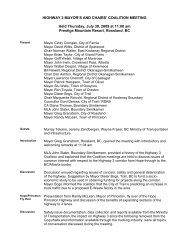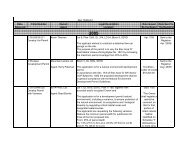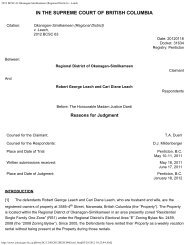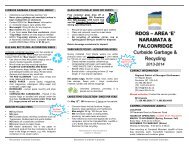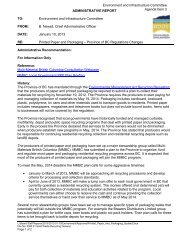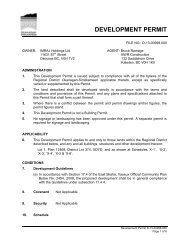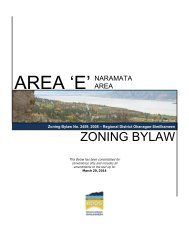Regional Heritage Strategic Plan 2013 - Rdosmaps.bc.ca
Regional Heritage Strategic Plan 2013 - Rdosmaps.bc.ca
Regional Heritage Strategic Plan 2013 - Rdosmaps.bc.ca
You also want an ePaper? Increase the reach of your titles
YUMPU automatically turns print PDFs into web optimized ePapers that Google loves.
Guidelines for Implementing Context Studies and<br />
Values-Based Management of Historic Places<br />
WHY USE VALUES-BASED MANAGEMENT<br />
IN MANY COMMUNITIES, heritage conservation has taken place outside of regular land-use planning activities. Typi<strong>ca</strong>lly,<br />
this has been the <strong>ca</strong>se be<strong>ca</strong>use the understanding of why historic places matter to a community is not<br />
strong; decision makers <strong>ca</strong>nnot justify public spending on places they don’t consider “heritage” in the traditional<br />
sense of the word.<br />
Best practice for heritage conservation planning in Canada – and British Columbia – follows a values-based approach<br />
to the stewardship and management of historic places. This approach allows the community to clearly<br />
articulate why historic places matter, and ensures confidence that identified heritage values remain for present<br />
and future generations. Historic places are no longer recognized, protected, and conserved based on just their<br />
architectural superiority or histori<strong>ca</strong>l associations. Instead, a values-based approach considers all aspects of a<br />
community’s development and evolution over time. It allows conservation of historic places to be an activity<br />
relevant to all members of a community, rather than an activity only understood by heritage “experts”. Understanding<br />
what a community values in terms of its heritage allows for a stronger justifi<strong>ca</strong>tion for ensuring that<br />
historic places remain as a community develops and changes over time.<br />
This management process uses heritage values to guide decision making about historic places. <strong>Heritage</strong> values<br />
are defined as the historic, aesthetic, spiritual, social, cultural, and scientific signifi<strong>ca</strong>nce or importance of a place<br />
for past, present, or future generations. When beginning a values-based management system, it is best to have<br />
an understanding of the heritage values of the community as a whole before trying to understand the signifi<strong>ca</strong>nce<br />
of individual places. The context study develops this big-picture understanding of why citizens <strong>ca</strong>re about<br />
the character and identity of the community, and how that has been shaped over time.<br />
<strong>Heritage</strong> conservation planning is a land-use decision-making process that takes into consideration the embodiment<br />
of values in a community’s historic places. It integrates the conservation of historic places and community<br />
development, so that the two are seen as one activity, rather than processes that occur on opposite ends of a<br />
spectrum. Context studies are designed to honour how a community evolved over time, and how distinctive<br />
events and eras of history have shaped what the community is today. By undertaking a context study, the community<br />
recognizes that the signifi<strong>ca</strong>nt elements of its past (as seen in its historic places) need not be sacrificed in<br />
order for development and change to continue.<br />
Generally, values-based management for heritage conservation planning follows the path outlined in Figure 1.<br />
Values are identified by a broad group of community members, historic places that represent those values are<br />
identified, and then land-use decision making and conservation activities for those places <strong>ca</strong>n occur.<br />
The context study typi<strong>ca</strong>lly covers the first two steps of the values-based management process. The following<br />
workshop activity section further explains the importance of these two steps in establishing a values-based<br />
foundation for the development of a community heritage planning program. Often, context study reports also<br />
address the third step in the process, by providing recommendations on actions and conservation tools that a<br />
community <strong>ca</strong>n implement to ensure that historic places are a viable part of the community’s growth and development.<br />
<strong>Regional</strong> <strong>Heritage</strong> Strategy | Request for Proposals August <strong>2013</strong> | 35<br />
www.for.gov.<strong>bc</strong>.<strong>ca</strong>/heritage Page 1






